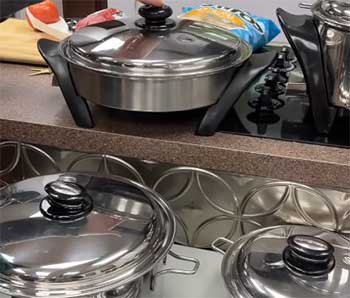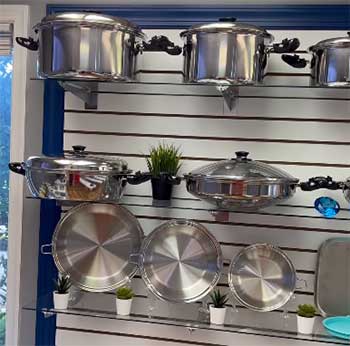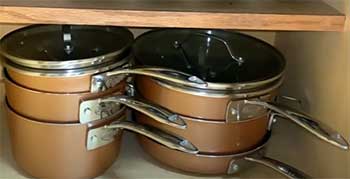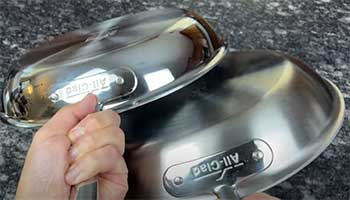I’m not one to throw money at fancy kitchen gear without good reason, but Saladmaster pots and pans?
They’re worth every penny. As someone who’s spent years cooking everything from quick weeknight dinners to elaborate holiday feasts, I’ve found Saladmaster’s quality, health-focused design, and durability to be game-changers.
This cookware isn’t just about cooking; it’s about cooking smarter, healthier, and with confidence. In this article, I’ll share my personal journey with Saladmaster, break down its pros and cons, offer maintenance tips, and compare it to other brands.
Trust me, by the end, you’ll see why Saladmaster deserves a spot in your kitchen.
My Journey With Saladmaster Cookware

Picture this: I’m standing in my kitchen, staring at a pile of mismatched pots and pans, some scratched, others warped from years of use.
I’d been skeptical about “premium” cookware, assuming it was all hype.
Then, a friend invited me to a Saladmaster dinner party.
I went for the free meal, expecting a sales pitch and little else. Instead, I was blown away.
The demonstrator cooked a full meal—veggies, chicken, even a dessert—using minimal water and no oil.
The flavors were vibrant, the cleanup was a breeze, and I was hooked.
I bought a starter set, a hefty investment at the time, and brought it home with a mix of excitement and buyer’s remorse. Would it really live up to the hype? My first test was a simple stir-fry.
I tossed in some vegetables, set the heat to medium, and waited for the vapor valve to click—a feature Saladmaster touts for signaling the perfect cooking temperature. The veggies came out crisp, flavorful, and nutrient-packed, without the greasy residue I was used to.
Next, I tried steaming fish. The tight-fitting lids locked in moisture, and the result was tender, perfectly cooked fish that didn’t need a drop of oil.
Over the months, I experimented with everything from soups to roasts. The even heat distribution meant no hot spots, no burnt edges. I started noticing I was using less seasoning because the cookware preserved the natural flavors of my ingredients.
Cleanup?
A dream. A quick scrub with a non-abrasive sponge, and the pans looked as shiny as the day I bought them. My old nonstick pans, which I’d replace every couple of years, were gathering dust in a cupboard.
Saladmaster wasn’t just cookware; it was a lifestyle shift. I was cooking healthier, wasting less, and enjoying the process more than ever.
But it wasn’t all smooth sailing. The price tag made me wince, and I had to learn to adjust to the low-heat cooking method. There were moments of frustration when I cranked the heat too high and food stuck.
Yet, the more I used Saladmaster, the more I appreciated its design. It forced me to slow down, to cook with intention. Now, years later, my set still looks pristine, and I’m convinced it’ll outlast me.
What Makes Saladmaster Stand Out?

Saladmaster’s claim to fame is its 316Ti stainless steel, a surgical-grade material infused with titanium.
Sounds fancy, right? It is. This isn’t your run-of-the-mill stainless steel.
It’s corrosion-resistant, non-reactive, and designed to keep your food free from harmful metals that can leach from cheaper cookware.
I’ve boiled acidic tomato sauces in these pans without worrying about metallic flavors or pitting.
The construction is multi-ply, with layers that distribute heat evenly, so you’re not stuck stirring obsessively to avoid scorching.
The vapor valve is another standout. It’s a small, clever feature on the lids that clicks when the pan reaches the ideal temperature for waterless cooking.
This method uses minimal water to steam food, locking in nutrients and flavor. I’ve cooked broccoli that stays bright green and crunchy, not mushy and faded like it used to in my old pots.
The handles are another win—ergonomic, heat-resistant, and riveted for durability. I’ve moved a steaming pot from stove to sink without grabbing a potholder, and the handles haven’t budged in years.
Saladmaster also pushes a health angle, and I’ll admit, I was skeptical at first. The idea of cooking with less oil and water sounded like marketing fluff. But after months of use, I noticed my meals tasted cleaner, and I wasn’t drowning everything in oil to prevent sticking.
The cookware’s design encourages low-heat cooking, which preserves vitamins and minerals. It’s not just about health, though—it’s about convenience.
The stackable design saves cabinet space, and the lifetime warranty gives me peace of mind that I’m not replacing these pans anytime soon.
The Downsides of Saladmaster
- The Eye-Watering Price Tag
Let’s not sugarcoat it: Saladmaster is expensive. My starter set cost more than my monthly grocery budget, and larger sets can run into the thousands. I get it—not everyone can justify dropping that kind of cash on cookware.
For me, the investment paid off over time, but it’s a tough sell if you’re on a tight budget. You’re paying for quality, durability, and the health benefits, but it’s still a significant upfront cost.
I’ve heard friends say they’d rather buy a full set of another brand for half the price, and I can’t entirely blame them.
- Adjusting to the Cooking Method

Saladmaster’s waterless cooking system takes some getting used to.
If you’re like me, raised on high-heat searing and boiling, the low-and-slow approach feels foreign.
My first few attempts were a disaster—I cranked the heat too high, and my food stuck like glue.
The vapor valve is supposed to guide you, but it’s subtle, and I missed the click more than once.
It took practice to trust the process, and I still occasionally miss the sizzle of a high-heat sear. If you’re impatient or love high-heat cooking, Saladmaster might test your patience.
- Limited Availability
You can’t just walk into a store and buy Saladmaster. It’s sold through direct sales, often via dinner parties or online demos. This exclusivity adds to the allure but also the hassle. I had to coordinate with a distributor, sit through a presentation, and wait for delivery.
It’s not as simple as clicking “add to cart” online. Plus, the sales model can feel pushy. I’ve heard stories of people feeling pressured to buy, which left a bad taste in my mouth. If you prefer a straightforward shopping experience, this could be a drawback.
- Maintenance Can Be Tricky
While Saladmaster is durable, it’s not indestructible. The stainless steel surface isn’t nonstick, so you need to be mindful of heat and oil to prevent sticking. I’ve had moments where I let a pan overheat, and scrubbing off stuck-on food was a chore.
The cookware also requires specific cleaning methods—no harsh abrasives or dishwasher trips. For someone used to tossing pans in the dishwasher, this was an adjustment. It’s not high-maintenance, but it’s not as carefree as nonstick pans.
How To Keep Your Saladmaster Shining?
- Cleaning Without the Hassle
Keeping your Saladmaster pans looking like new isn’t hard, but it requires a bit of care. Use a non-abrasive sponge or cloth with warm water and mild dish soap. For stubborn stuck-on food, fill the pan with hot water, add a splash of white vinegar, and let it simmer for 10 minutes.
Scrub gently, and it’ll come clean. Avoid steel wool or harsh cleaners—they’ll scratch the surface and ruin that mirror finish. I keep a dedicated sponge for my Saladmaster to avoid cross-contamination with greasy dishes.
- Preventing Sticking
Sticking is the bane of stainless steel, but you can minimize it. Always preheat your pan on medium heat until the vapor valve clicks, then reduce to low. I add a tiny bit of oil for high-protein foods like eggs or fish, even though Saladmaster claims you don’t need it.
If food does stick, don’t panic. Soak the pan in warm water for 15 minutes, then scrub gently. I’ve also found that letting the pan cool completely before cleaning makes a big difference—hot stainless steel is more prone to sticking if you rush to wash it.
- Storing for Longevity
Saladmaster’s stackable design is a space-saver, but improper storage can lead to scratches. I stack my pans with a soft cloth or paper towel between them to protect the cooking surface.
Keep lids on to prevent dust buildup, and store in a dry cabinet to avoid moisture, which can cause water spots. If you’re tight on space, consider hanging your pans on a rack—mine look like a shiny art installation in my kitchen.
Just make sure the hooks are padded to avoid scratching.
- Handling with Care
The handles are sturdy, but don’t abuse them. I’ve seen people toss their pans around like they’re indestructible, but rough handling can loosen rivets over time. When moving a hot pan, grip the handle firmly but don’t yank.
If you’re cooking on gas or electric, avoid letting flames or coils extend beyond the pan’s base—it can discolor the sides. I also check the vapor valve occasionally to ensure it’s not clogged with food particles, which can affect its performance.
- Polishing for That Showroom Shine
To keep that mirror finish gleaming, I polish my pans every few months with a stainless steel cleaner or a homemade mix of vinegar and baking soda. Apply with a soft cloth, rub gently, and rinse thoroughly. It’s like giving your pans a spa day—they come out sparkling.
Avoid abrasive powders or pads, as they’ll dull the finish. I’ve found that a quick polish before a dinner party makes my kitchen look like it belongs in a magazine.
Comparing Saladmaster To Other Brands
- SODAY Pots and Pans

SODAY cookware caught my eye as a budget-friendly alternative, promising similar waterless cooking benefits. I borrowed a friend’s SODAY set to see how it stacked up. The construction is solid, with multi-ply stainless steel, but it lacks the 316Ti titanium alloy that makes Saladmaster stand out.
SODAY’s heat distribution is decent, but I noticed hot spots when cooking larger dishes like roasts. The lids fit well, but they don’t have the vapor valve, so you’re guessing when the temperature is right.
Cleanup was straightforward, though the interior finish scratched more easily than Saladmaster’s. Price-wise, SODAY is significantly cheaper, often a third of Saladmaster’s cost, making it tempting for casual cooks.
However, the handles felt less sturdy, and I questioned their long-term durability compared to Saladmaster’s riveted design. If you’re after affordability and don’t mind sacrificing some precision, SODAY is a solid choice, but it doesn’t match Saladmaster’s health-focused engineering or longevity.
- Stackmaster Pots and Pans

Stackmaster is another player in the waterless cookware game, and I tested it at a neighbor’s house.
Its seven-ply construction is impressive, and the pans feel hefty, much like Saladmaster.
The cooking experience was smooth—veggies steamed nicely, and the heat distribution was even, though not as flawless as Saladmaster’s. The big difference? Stackmaster’s lids lack the vapor valve, which I missed when trying to nail the low-heat sweet spot.
The handles are ergonomic but screwed on, not riveted, and I noticed slight wobbling after heavy use. Stackmaster’s price is closer to Saladmaster’s than SODAY’s, but still lower, often by 20-30%.
Cleanup was easy, though the interior showed faint scratches after a few uses. Stackmaster is a strong contender for those who want premium cookware without Saladmaster’s steep price, but its warranty isn’t as comprehensive, and I’m not convinced it’ll last decades like my Saladmaster set.
- All-Clad Cookware

All-Clad is a heavyweight in the cookware world, and I’ve used it at a friend’s professional kitchen.
Its tri-ply stainless steel is top-notch, with an aluminum core for excellent heat conductivity.
Cooking with All-Clad felt familiar—great for high-heat searing, which Saladmaster doesn’t excel at.
However, All-Clad doesn’t emphasize waterless cooking, so you’re not getting the same health benefits or nutrient retention.
The handles are solid but get hot, unlike Saladmaster’s heat-resistant ones. All-Clad is widely available in stores, a big plus over Saladmaster’s direct-sales model. Price-wise, All-Clad is expensive but often cheaper than Saladmaster’s larger sets.
Durability is comparable, but All-Clad’s warranty isn’t as ironclad. If you prioritize versatility and don’t care about waterless cooking, All-Clad is fantastic. For health-conscious cooks like me, Saladmaster’s specialized design wins out.
- Maxam Waterless Cookware
Maxam is often pitched as a budget-friendly Saladmaster dupe, and I tested a set to see if it held up. Its nine-element construction sounds impressive, but the pans felt lighter than Saladmaster’s. Heat distribution was good for steaming but less consistent for larger dishes.
The lids are tight-fitting, but without the vapor valve, I struggled to gauge the right temperature. Maxam’s price is a fraction of Saladmaster’s—sometimes under $300 for a full set—which is a huge draw.
However, the handles felt flimsier, and the interior showed wear after a few months of use. Cleanup was simple, but the mirror finish dulled faster than I expected.
Maxam is great for those dipping their toes into waterless cooking without breaking the bank, but it lacks Saladmaster’s premium materials and lifetime durability.
Frequently Asked Questions (FAQ)
Saladmaster’s uniqueness lies in its 316Ti stainless steel, a surgical-grade material that resists corrosion and doesn’t leach harmful metals into food. Its multi-ply construction ensures even heat distribution, and the vapor valve on the lids signals the perfect temperature for waterless cooking, preserving nutrients and flavor. The cookware is designed for low-heat, low-oil cooking, promoting healthier meals. The riveted, heat-resistant handles and stackable design add durability and convenience. Plus, the lifetime warranty means you’re covered for decades, making it a long-term investment for health-conscious cooks.
It depends on your priorities. Saladmaster excels in waterless cooking, using minimal water and oil to retain nutrients, thanks to its 316Ti stainless steel and vapor valve. It’s ideal for health-focused cooks and has a lifetime warranty. All-Clad, with its tri-ply construction, is better for high-heat cooking like searing and is more widely available. Its handles get hot, and it lacks the waterless feature, but it’s often cheaper. If health and longevity are key, Saladmaster wins; for versatility and accessibility, All-Clad is the better pick.
Sticking happens if you don’t follow Saladmaster’s low-heat cooking method. Preheat the pan on medium until the vapor valve clicks, then reduce to low. If you crank the heat too high, food—especially proteins like eggs—can stick. Using a touch of oil helps, even though Saladmaster claims you don’t need it. Ensure the pan is clean and dry before cooking, as residue can cause sticking. If food sticks, soak the pan in warm water with vinegar for 15 minutes and scrub gently with a non-abrasive sponge.
No, Saladmaster cookware is made in the USA, specifically in Wisconsin by Regal Ware. The company emphasizes its American manufacturing as a mark of quality, using 316Ti stainless steel and titanium. This sets it apart from many competitors, some of which, like certain Maxam sets, are produced in China. Saladmaster’s made-in-USA label is a big part of its appeal, ensuring high standards and durability, though it contributes to the higher price tag.
Why Saladmaster Wins My Heart?
If you’re serious about cooking healthier, tastier meals with cookware that’ll last a lifetime, Saladmaster is the way to go. I’ve shared my journey, the highs and lows, and how it stacks up against brands like SODAY, Stackmaster, All-Clad, and Maxam.
The price might make you hesitate, but the durability, health benefits, and ease of use make it a worthy investment. With proper care, these pans will be your kitchen companions for decades.
Trust me, once you cook with Saladmaster, you’ll wonder why you didn’t make the switch sooner.
